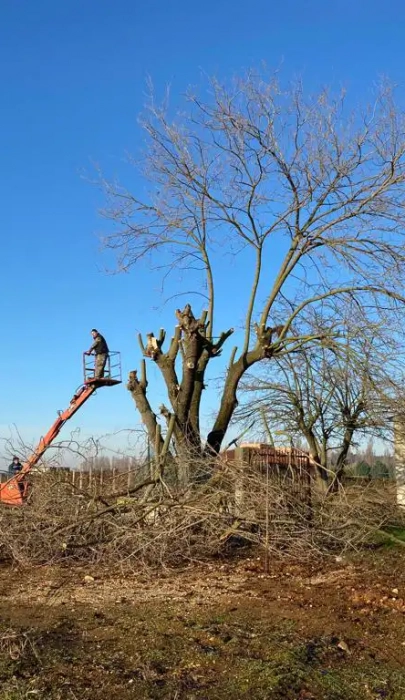Mauro is driven by a real "sacred fire" to save mulberry trees.
He does not ask himself why he does so, it is an inner force that sustains him: the
impulse to save beauty. These silent giants, each one different from the other, tell stories of people and villages, of work and fatigue, they stretch their dark, bare branches towards the sky in winter and cover them with green every spring, their roots firmly anchored in the ground to suck the life out of hundreds of years. His passion is not only aesthetic, but also valuable in terms of preserving the agricultural biodiversity of the countryside. "Once upon a time, mulberry trees were part of the identity of these places," he says, "when sericulture was the first income of the year for peasant families and the reeling industry was still
tied to the territory. With the loss of this tradition, many of these unique trees have been cut down to
make way for new crops or infrastructure, but also due to neglect and disinterest on the part of the owners of the land on which they grew. Rizzotti is personally responsible for relocating these historic plants and finding them a new 'home' in his own mulberry orchard. "It is an activity that I have undertaken out of passion and with my own economic resources. I have always been impressed by the beauty and variety of mulberry trees and how their shape tells the story of an area”.


The trees found in Mantua are completely different from those growing in Castelfranco, Bassano del Grappa, or in any other town in Friuli.
The specificity and diversity of the mulberry trees can be
appreciated with the naked eye, just by walking through the area,' comments the nurseryman, who
personally shows us the differences between the varieties he has collected along the rows. Such diverse
and ancient plants contain within them a legacy of genes selected by farmers over the centuries: our
ancestors reproduced the individuals they considered to be the strongest, the healthiest, the longest-
lived, and the most productive. The genetic code of these giants contains the information that
differentiated them from so many other seedlings, that made them resistant to disease, or insects, or
salinity, or drought, or even to stagnant water at the roots. They are a treasure trove of what is technically
known as 'agricultural biodiversity'. Immersed in the silence between the broad trunks, we can breathe in the vital breath of these trees of which the owner is not only the protector, but also the healer. "Many of
the plants I buy are sick or about to be cut down," he explains with some emotional affection, "owners
who no longer want them on their land often make chainsaw cuts at the base of the trees to let them die.
I can't save them all, and I’ve made a lot of mistakes myself, learning as I went along for twenty-years ' .
For each one I remember where it came from, and the effort I put into recovering it.
Mauro's work touches every moment of his life, and his relationship with his plants is now more than just
a passion. "Many of my trees have names, and I have known their strengths and weaknesses for many
years". His pride and
joy are three majestic mulberry trees, almost four hundred years old, originally from Villafranca (VR), for
each of which he had to work hard to get them out from the ground transport them. "I spent around
15,000 euro to moving each one," he says, "and the owner wanted me to take them all. I had to make the
journey in a single night, but it was worth it".
Mauro's latest project was the purchase and relocation of 'Napoleon', a monumental mulberry tree that
he found in the province of Mantua, named after the French general, who according to a popular
tradition, would rested under its branches.
'Napoleon could not stand in a row with all the other mulberry trees in a row, its roots are too extensive and it needs space,' he explains excitedly. 'I had to buy a
special piece of land. The events of Mauro's life are inextricably linked to his passion, which he transmits to everyone around
around him: Laura, his partner, helps him prune the mulberry trees, and she has involved the primary
school classes of Vivaro, where she teaches; she is now known as the 'teacher of the morars
(mulberries)', in an awareness-raising project.
"Even my neighbours," says Mauro, "when they started to sell the land around my mulberry orchard, they
liked the idea of me buying it, because they recognised the beauty and the value of this initiative to
improve the area"
A story, Mauro's, that takes us back to the roots of the tradition of mulberry growing in Italy; mulberry
trees have not been cultivated for productive reasons for almost a century, and the trees we find on the
sides of our roads, near old houses, along ditches and headlands are the legacy of an ancient activity. If
no one thought to save these old and fragile specimens, the genetic resources they guard would be lost
and we would no longer be able to recover and improve them. In fact, the mulberry tree is a species that
is currently being studied for its multiple uses: as a woody biomass plant, as fodder, for the production of
fruit, paper, medicinal substances, and last but not least, for the revival of sericulture.
The mulberry tree is, therefore, "biodiversity that creates biodiversity".
Mauro Rizzotti's activity deserves to be recognised in the general context of the enhancement of Friuli's countryside, and cannot be reduced to a purely personal pleasure; his work is hard work, diligence and a dream: 'SometimesI feel tired; it has not been easy to devote so much time to what is largely a passion without profit, and I am not sure I can continue forever.
I would like my work to be passed on to future generations, and my greatest
wish would be to turn my mulberry orchard into a park, a monument to celebrate this wonderful plant, a testimony to our history, to the beauty of nature and the importance of a fruitful coexistence between man and the environment'. Who knows, the ARACNE project could be the beginning of the realisation of this dream, and the planned creation of a cultural tourist route along the Silk Road may include an important stop in Vivaro.


